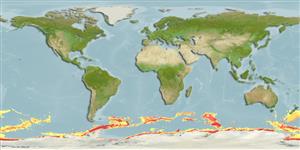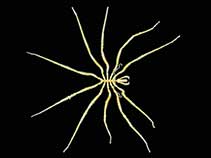Pentanymphon antarcticum Hodgson, 1904
| Native range | All suitable habitat | Point map | Year 2050 |

|
| This map was computer-generated and has not yet been reviewed. |
| Pentanymphon antarcticum AquaMaps Data sources: GBIF OBIS |
Classification / Names ชื่อสามัญ | ชื่อพ้อง | CoL | ITIS | WoRMS
Pycnogonida | Pantopoda | Nymphonidae
Environment: milieu / climate zone / ระดับความลึก / distribution range นิเวศวิทยา
; ระดับความลึก 3 - 3227 m (อ้างอิง 1680). Polar
Distribution ประเทศต่างๆ | พื้นที่จำแนกตาม FAO | ระบบนิเวศหลายระบบ | การปรากฏขึ้น,การเกิดขึ้น,พบ | การแนะนำ
Southwest Pacific and Antarctic: Antarctica, South Orkney, South Shetland and New Zealand.
Length at first maturity / ขนาด / Weight / Age
วัยเจริญพันธุ์: Lm ? range ? - ? cm
Short description สัณฐานวิทยา
Life cycle and mating behavior วัยเจริญพันธุ์ | การสืบพันธุ์ | การวางไข่ | Eggs | ความดกของไข่ | Larvae
Main reference
อ้างอิง | ผู้ประสานงาน | ผู้ร่วมมือ
Child, C.A. 1998 The marine fauna of New Zealand: Pycnogonida (sea spiders). NIWA Biodiversity Memoire 109. National Institute of Water and Atmospheric Research (NIWA). Washington, D.C. 20530, USA. 71 p. + Figure 2A-G, 3A-F, 4, 5. (อ้างอิง 9)
IUCN Red List Status
(อ้างอิง 130435: Version 2025-1)
CITES status (อ้างอิง 108899)
CMS (อ้างอิง 116361)
Threat to humans
Human uses
| FishSource |
เครื่องมือ
ข้อมูลเพิ่มเติม
Max. ages / sizes
Length-weight rel.
Length-length rel.
Length-frequencies
Mass conversion
อุดมสมบรูณ์
แหล่งที่มาจากอินเตอร์เน็ต
BHL | BOLD Systems | CISTI | DiscoverLife | FAO(Publication : search) | Fishipedia | GenBank (genome, nucleotide) | GloBI | Gomexsi | Google Books | Google Scholar | Google | PubMed | แผนภูมิชีวิตแบบต้นไม้ | Wikipedia (Go, ค้นหา) | บันทึกทางด้านสัตววิทยา



